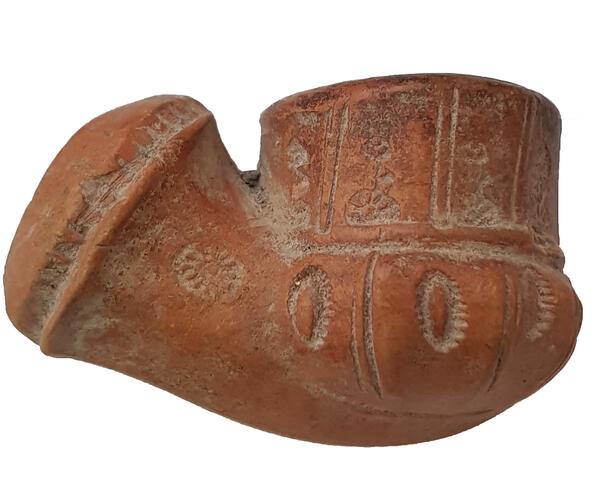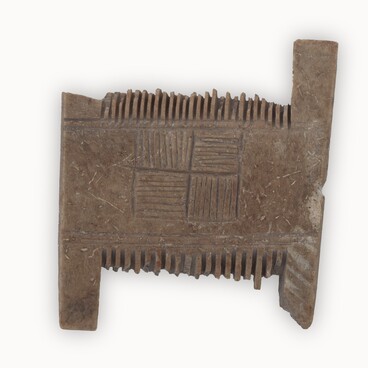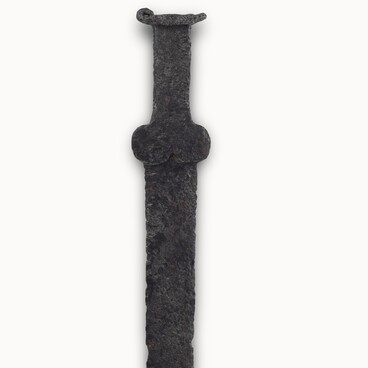The Kursk Regional Museum of Archaeology displays a clay smoking pipe.
In 2004, archaeological excavations led by Nikolai Alekseevich Tikhomirov were carried out in the central part of Kursk. In the yard of a house on Lenin Street the archaeologists registered pit 1. It was filled mainly with dark gray meshed soil. They found 72 ceramic smoking pipes, which were arranged in a compact group.
One of them is a red-clay pipe with an ellipsoidal faceted foot, ten-sided bowl and a distinguished heel, as well as an octagonal chamber. It has an embossed rim. The pipe is ornamented with a set of stamps. In Russian historiography such goods are usually referred to a group called “tahta chubuk” — Turkish ornamented pipes. The earliest period when such pipes were used may go back to the middle of the 18th century. The latest one covers the 19th century.
In Russia smoking tobacco became widely popular under Peter I, when the sale of tobacco in drinking establishments was officially allowed. A decree, allowing “to sell tobacco in taverns openly” was issued.
From 1699 in Moscow and all Russian cities the monopoly right to trade in tobacco, tobacco pipes and other smoking accessories was handed over for six years to an English tobacco company. Prior to this legalization, people caught selling tobacco were subjected to various corporal punishments, such as whipping. Since the second half of the 18th century, there was a sharp decrease in the price of raw tobacco, and trade contacts with the Ottoman Empire began to develop. All this contributed to the increase in tobacco smoking among different groups of population. Expensive “Dutch” clay pipes were replaced by Turkish ones. Drinking establishments and coffee houses remained the main places where one could indulge in this unhealthy habit. There one could buy tobacco or order a pipe.
As of today, researchers have distinguished several stages in the spread of the fashion for smoking Turkish clay pipes. At the first stage pipes were really imported from Turkey. They were used by military men and tradesmen who bought them directly in the places where they were produced. At the second stage pipe smoking was became fashionable among the aristocracy, but the goods were still ordered from abroad. At the third stage the smoking pipes became part of the everyday life of the petty bourgeoisie and even rose in popularity among peasants. The mass demand stimulated local craftsmen to produce pipes by copying foreign products. At the last stage there were some designs which were unknown on the territory of Turkey.
In 2004, archaeological excavations led by Nikolai Alekseevich Tikhomirov were carried out in the central part of Kursk. In the yard of a house on Lenin Street the archaeologists registered pit 1. It was filled mainly with dark gray meshed soil. They found 72 ceramic smoking pipes, which were arranged in a compact group.
One of them is a red-clay pipe with an ellipsoidal faceted foot, ten-sided bowl and a distinguished heel, as well as an octagonal chamber. It has an embossed rim. The pipe is ornamented with a set of stamps. In Russian historiography such goods are usually referred to a group called “tahta chubuk” — Turkish ornamented pipes. The earliest period when such pipes were used may go back to the middle of the 18th century. The latest one covers the 19th century.
In Russia smoking tobacco became widely popular under Peter I, when the sale of tobacco in drinking establishments was officially allowed. A decree, allowing “to sell tobacco in taverns openly” was issued.
From 1699 in Moscow and all Russian cities the monopoly right to trade in tobacco, tobacco pipes and other smoking accessories was handed over for six years to an English tobacco company. Prior to this legalization, people caught selling tobacco were subjected to various corporal punishments, such as whipping. Since the second half of the 18th century, there was a sharp decrease in the price of raw tobacco, and trade contacts with the Ottoman Empire began to develop. All this contributed to the increase in tobacco smoking among different groups of population. Expensive “Dutch” clay pipes were replaced by Turkish ones. Drinking establishments and coffee houses remained the main places where one could indulge in this unhealthy habit. There one could buy tobacco or order a pipe.
As of today, researchers have distinguished several stages in the spread of the fashion for smoking Turkish clay pipes. At the first stage pipes were really imported from Turkey. They were used by military men and tradesmen who bought them directly in the places where they were produced. At the second stage pipe smoking was became fashionable among the aristocracy, but the goods were still ordered from abroad. At the third stage the smoking pipes became part of the everyday life of the petty bourgeoisie and even rose in popularity among peasants. The mass demand stimulated local craftsmen to produce pipes by copying foreign products. At the last stage there were some designs which were unknown on the territory of Turkey.



